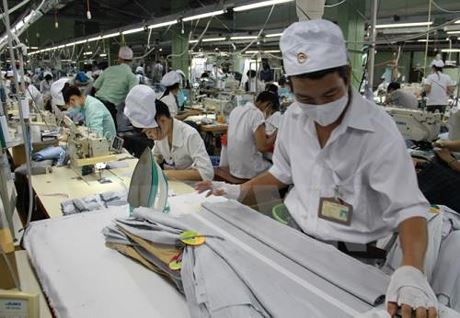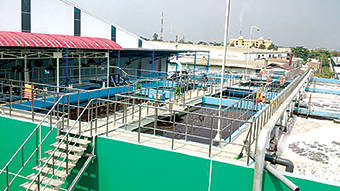

10/01/2018
With the development of the society over the years, the textile and garment industry has rapidly increased production outputs. This industry attracts a large number of employees, of about more than 2.5 million ones, with more than 5,000 enterprises. However, the development of the textile and garment industry also entails the consequences of environmental pollution. In order to improve production capacity, reduce waste and save on natural resources, the textile and garment industry has applied cleaner production solutions to change production patterns towards becoming more sustainable and environmentally friendly.
 |
| Implementing cleaner production has helped textile and garment enterprises save energy and reduce waste |
Vietnam Textile and Garment Industry is facing the problem of environmental pollution due to dyeing wastewater with large chemical residue. According to the study, in the dyeing textile wastewater there are substances easy for microbial dissolution such as tapioca flour using warp yarns, and those difficult such as polyvinyl acetate, disperse dyes, reactive dyestuffs and substances for fabric bleaching. The more synthetic fibers there are in fabrics, such as polyesters, the more dyes and auxiliaries, which are difficult for microbial dissolution, are used, resulting in higher amount of pollutants in the wastewater. In order to ensure economic and environmental benefits, the application of cleaner production has helped textile and garment enterprises save on energy, reduce wastes and reduce input costs and environmental treatment costs, at the same time, improve the quality and lower the price of products. In fact, many textile and garment enterprises have reduced from 20 to 30% of the pollutant load without any investment cost thanks to the application of gas emission treatment technology through boiler gas collection; using rational consumption norms of dyeing textile material sources. For example, the Hanoi Textile and Garment Joint Stock Corporation (Hanosimex), with its textile-fiber production operations, the primarily concerned environment matter is about emissions, dust and noise when spinning. To minimize pollution, from 2014, Hanosimex has invested 500 million VND to install inverters for ventilating fans and use energy saving bulbs. Thus, Hanosimex has saved over 4 million kwh/year, reducing 4,000 tons of CO2/year. At textile workshops, Hanosimex has invested in dust collector system at boilers using water, reducing 3- 5% air pollution and increasing boiler efficiency. Similarly, Tien Hung Joint Stock Company (Hung Yen) has installed two heat pumps to replace the boilers; used 35 LEDs to replace compact lights; installed inverters for pump system, etc. These devices have helped the company save 177.6 million per year of energy costs.
However, the current rate of application of cleaner production in textile and garment enterprises is not high, due to low awareness of enterprises. Some textile and garment enterprises stated that cleaner production was only related to sanitation and suggested that cleaner production could be costly for enterprises. In addition, because the investment in production (especially water and labours) is still low in many countries in the region, enterprises have not recognized the importance of increasing the efficiency of resource use. In addition, many enterprises do not understand the polluters pay principle and consider environmental protection a matter of the State. Enterprises also have not recognized the benefits of cleaner production and assumed that cleaner production is the construction of waste treatment system, which will increase the cost. Besides, many enterprises still maintain the production technology systems that are obsolete and energy consuming, with limited technical capacity, resulting in no energy saving and causing high emissions. On the other hand, technical guidance in cleaner production implementation is often based on a network of consultants, but even cleaner production consultants are lacking in quantity and quality.
In order to become a strong economic sector with high and sustainable growth rate, in the coming years, the textile and garment industry should step up the implementation of cleaner production solutions such as strengthening the implementation of cleaner production consultation support for textile and garment enterprises through the Industrial Extension Centers. The State should adopt policies to encourage textile and garment enterprises to use cleaner production technologies and processes and gradually implement environmental management solutions. For companies, production units, especially private units, joint ventures, or 100% foreign capital companies in the dyeing sector, it is necessary to apply the management sanctions on dyeing textile material and fuel consumption norms; and the control of importation of machinery, materials, especially inert substances and dyes.
 |
| The textile and garment industry needs to develop and implement a road-map for environmentally friendly technology innovation. |
In addition, the textile and garment industry must develop an Environmental Impact Assessment reports in line with the sector's development strategy and environmental legislation; concentrate on thoroughly handling establishments which cause serious environmental pollution; set up textile garment industrial zones and clusters with concentrated wastewater treatment systems meeting environmental standards so as to relocate garment and textile establishments that may cause pollution. At the same time, it is necessary to encourage enterprises to apply environmental management standards in accordance with ISO 14000, creating a good working environment for employees according to SA 8000 Standard.
Particularly, the textile and garment industry needs to develop and implement a road-map for environmentally friendly technology innovation, enhancing the capacity of scientific and technological researches on the environment, etc. in order to meet the environmental and technical requirements for international economic integration. In addition, when Vietnam joins TPP, the "passport" for textile and garment enterprises is not only a standard on social responsibility, but also includes environmental standards; among them, the most common are the standards of green production, wastewater treatment, solutions for recycling of by-products arising in production, etc. In addition, it is necessary to encourage textile and garment enterprises to create a good working environment for employees.
However, for the successful implementation of the cleaner production program, one of the most important factors is that textile and garment enterprises need to set up a cleaner production task force. For large enterprises, the cleaner production task force can consist of a core team (including representatives of different departments) and some other members responsible for each specific task. For small and medium enterprises, the cleaner production task force may consist of only the enterprise owner and a manager who monitors daily activities. This group will be responsible for initiating, coordinating and monitoring the cleaner production assessment activity. In order to be effective, the task force basically must have sufficient knowledge to analyze and review current production practices of enterprises. Experts in the task force need to have innovation capacity to explore, develop and evaluate improvements in production practices, as well as implement monitoring and examining measures to increase waste minimization.
Dr. Phùng Thị Quỳnh Trang
Hanoi Industrial Textile Garment University